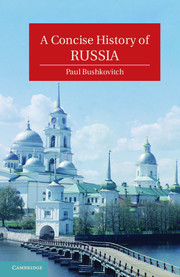Book contents
- Frontmatter
- Contents
- List of Figures
- Abbreviations
- Acknowledgments
- Prologue
- 1 Russia before Russia
- 2 Moscow, Novgorod, Lithuania, and the Mongols
- 3 The Emergence of Russia
- 4 Consolidation and Revolt
- 5 Peter the Great
- 6 Two Empresses
- 7 Catherine the Great
- 8 Russia in the Age of Revolution
- 9 The Pinnacle of Autocracy
- 10 Culture and Autocracy
- 11 The Era of the Great Reforms
- 12 From Serfdom to Nascent Capitalism
- 13 The Golden Age of Russian Culture
- 14 Russia as an Empire
- 15 Autocracy in Decline
- 16 War and Revolution
- 17 Compromise and Preparation
- 18 Revolutions in Russian Culture
- 19 Building Utopia
- 20 War
- 21 Growth, Consolidation, and Stagnation
- 22 Soviet Culture
- 23 The Cold War
- Epilogue
- Further Reading
- Index
3 - The Emergence of Russia
Published online by Cambridge University Press: 05 June 2012
- Frontmatter
- Contents
- List of Figures
- Abbreviations
- Acknowledgments
- Prologue
- 1 Russia before Russia
- 2 Moscow, Novgorod, Lithuania, and the Mongols
- 3 The Emergence of Russia
- 4 Consolidation and Revolt
- 5 Peter the Great
- 6 Two Empresses
- 7 Catherine the Great
- 8 Russia in the Age of Revolution
- 9 The Pinnacle of Autocracy
- 10 Culture and Autocracy
- 11 The Era of the Great Reforms
- 12 From Serfdom to Nascent Capitalism
- 13 The Golden Age of Russian Culture
- 14 Russia as an Empire
- 15 Autocracy in Decline
- 16 War and Revolution
- 17 Compromise and Preparation
- 18 Revolutions in Russian Culture
- 19 Building Utopia
- 20 War
- 21 Growth, Consolidation, and Stagnation
- 22 Soviet Culture
- 23 The Cold War
- Epilogue
- Further Reading
- Index
Summary
At the end of the fifteenth century, Russia came into being as a state – no longer just a group of related principalities. Precisely at this time in written usage the modern term Rossia (a literary expression borrowed from Greek) began to edge out the traditional and vernacular Rus. If we must choose a moment for the birth of Russia out of the Moscow principality, it is the final annexation of Novgorod by Grand Prince Ivan III (1462–1505) of Moscow in 1478. By this act, Ivan united the two principal political and ecclesiastical centers of medieval Russia under one ruler, and in the next generation he and his son Vasilii III (1505–1533) added the remaining territories. In the west and north, the boundaries they established are roughly those of Russia today, while in the south and east the frontier for most of its length remained the ecological boundary between forest and steppe. In spite of later expansion, this territory formed the core of Russia until the middle of the eighteenth century, and it contained most of the population and the centers of state and church. The Russians were still a people scattered along the rivers between great forests.
In the south and east, mostly beyond the forests and out in the steppe, Russia's neighbors remained the Tatar khanates that emerged in the 1430s from the breakup of the Golden Horde: Kazan, Crimea in the Crimean peninsula, and the Great Horde ruling the steppe. The Great Horde in turn broke up around 1500 to form the khanate of Astrakhan on the lower Volga and farther east the Nogai Horde. Farther east the khanate of Siberia held sway over the tiny population of the vast plain of the Ob’ and Irtysh rivers. These states were complex social organisms. Kazan’ was the only one to occupy part of the forest zone, and its people settled along the rivers and farmed the land like the Russians but with a nomadic appendage where the steppe began to the southeast. The Nogais were pure nomads. Crimea and Astrakhan’ were somewhere in between, their population made up of mostly steppe dwellers, but Astrakhan’ was a town and Crimea had towns and garden agriculture. Its location meant that it had a lively trade and close political ties with its great neighbor to the south, the Ottoman Empire.
- Type
- Chapter
- Information
- A Concise History of Russia , pp. 37 - 58Publisher: Cambridge University PressPrint publication year: 2011

